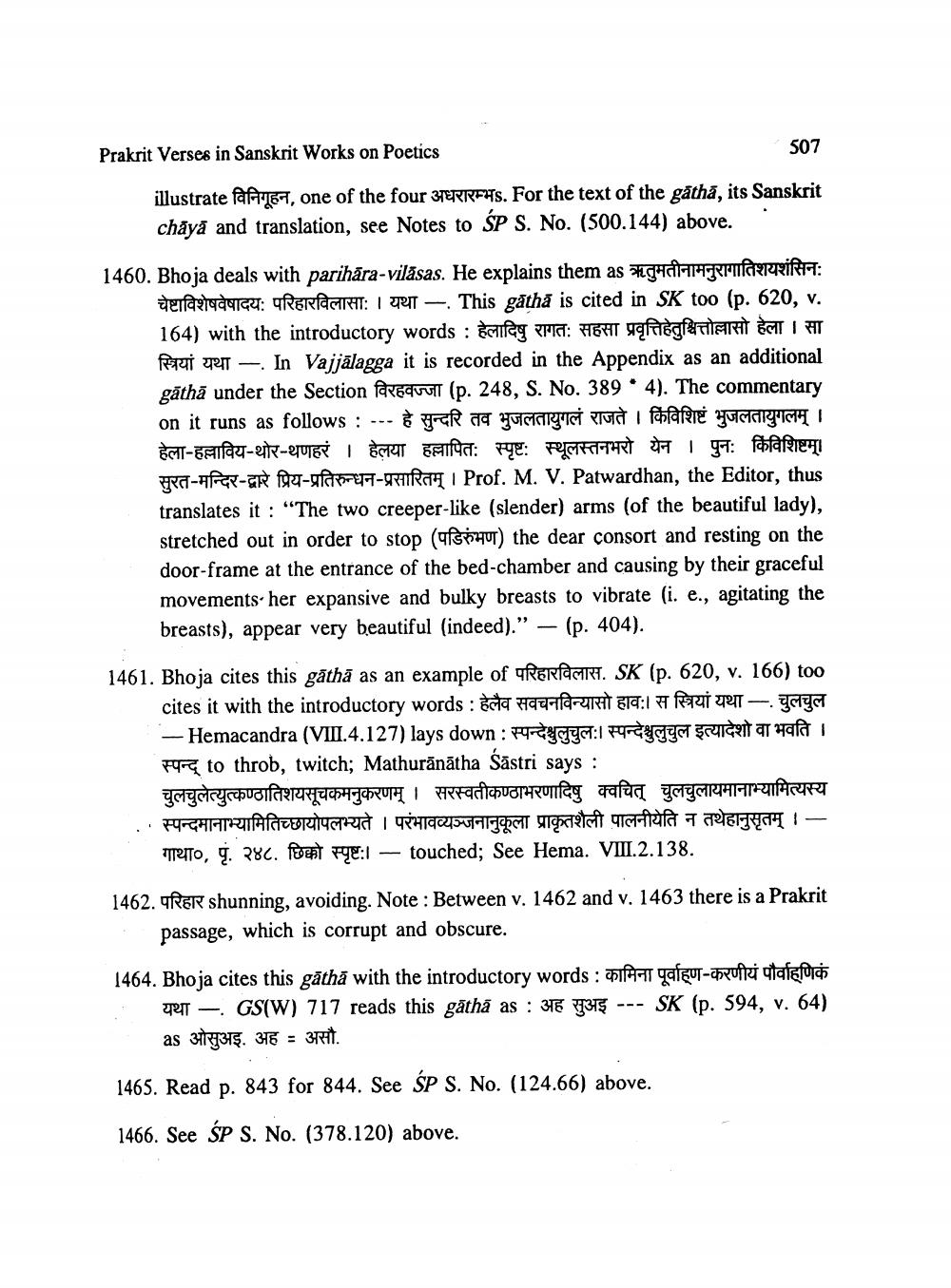________________
Prakrit Verses in Sanskrit Works on Poetics
507
illustrate विनिगूहन, one of the four अधरारम्भs. For the text of the gatha, its Sanskrit chaya and translation, see Notes to SP S. No. (500.144) above.
1460. Bhoja deals with parihara-vilasas. He explains them as ऋतुमतीनामनुरागातिशयशंसिन:
चेष्टाविशेषवेषादय: परिहारविलासा: । यथा -. This gatha is cited in SK too (p. 620, v. 164) with the introductory words : हेलादिषु रागत: सहसा प्रवृत्तिहेतुश्चित्तोल्लासो हेला । सा स्त्रियां यथा - In Vajjalagga it is recorded in the Appendix as an additional gāthā under the Section विरहवज्जा (p. 248,S. No. 389* 4). The commentary on it runs as follows : ... हे सुन्दरि तव भुजलतायुगलं राजते । किंविशिष्टं भुजलतायुगलम् । हेला-हल्लाविय-थोर-थणहरं । हेलया हल्लापित: स्पृष्टः स्थूलस्तनभरो येन । पुन: किंविशिष्टम्। सुरत-मन्दिर-द्वारे प्रिय-प्रतिरुन्धन-प्रसारितम् । Prof. M. V. Patwardhan, the Editor, thus translates it : "The two creeper-like (slender) arms (of the beautiful lady), stretched out in order to stop (SHU) the dear consort and resting on the door-frame at the entrance of the bed-chamber and causing by their graceful movements her expansive and bulky breasts to vibrate (i. e., agitating the breasts), appear very beautiful (indeed)." - (p. 404).
1461. Bhoja cites this gatha as an example of परिहारविलास. SK (p. 620, v. 166) too
cites it with the introductory words : हेलैव सवचनविन्यासो हावः। स स्त्रियां यथा-चुलचुल -Hemacandra (VIII.4.127) lays down : स्पन्देश्चलुचुल:। स्पन्देश्चलुचुल इत्यादेशो वा भवति । स्पन्द् to throb, twitch; Mathuranatha Sastri says :
चुलचुलेत्युत्कण्ठातिशयसूचकमनुकरणम् । सरस्वतीकण्ठाभरणादिषु क्वचित् चुलचुलायमानाभ्यामित्यस्य . . स्पन्दमानाभ्यामितिच्छायोपलभ्यते । परंभावव्यञ्जनानुकूला प्राकृतशैली पालनीयेति न तथेहानुसृतम् । -
गाथा०, पृ. २४८. छिक्को स्पृष्टः। - touched; See Hema. VIII.2.138.
1462. परिहार shunning, avoiding. Note : Between v. 1462 and v. 1463 there isaPrakrit
passage, which is corrupt and obscure.
1464. Bhoja cites this gatha with the introductory words : कामिना पूर्वाह्ण-करणीयं पौर्वाहणिकं
यथा - GS(W) 717 reads this gatha as : अह सुअइ --- SK (p. 594, v. 64) as ओसुअइ. अह = असौ.
1465. Read p. 843 for 844. See $P S. No. (124.66) above. 1466. See SP S. No. (378.120) above.




